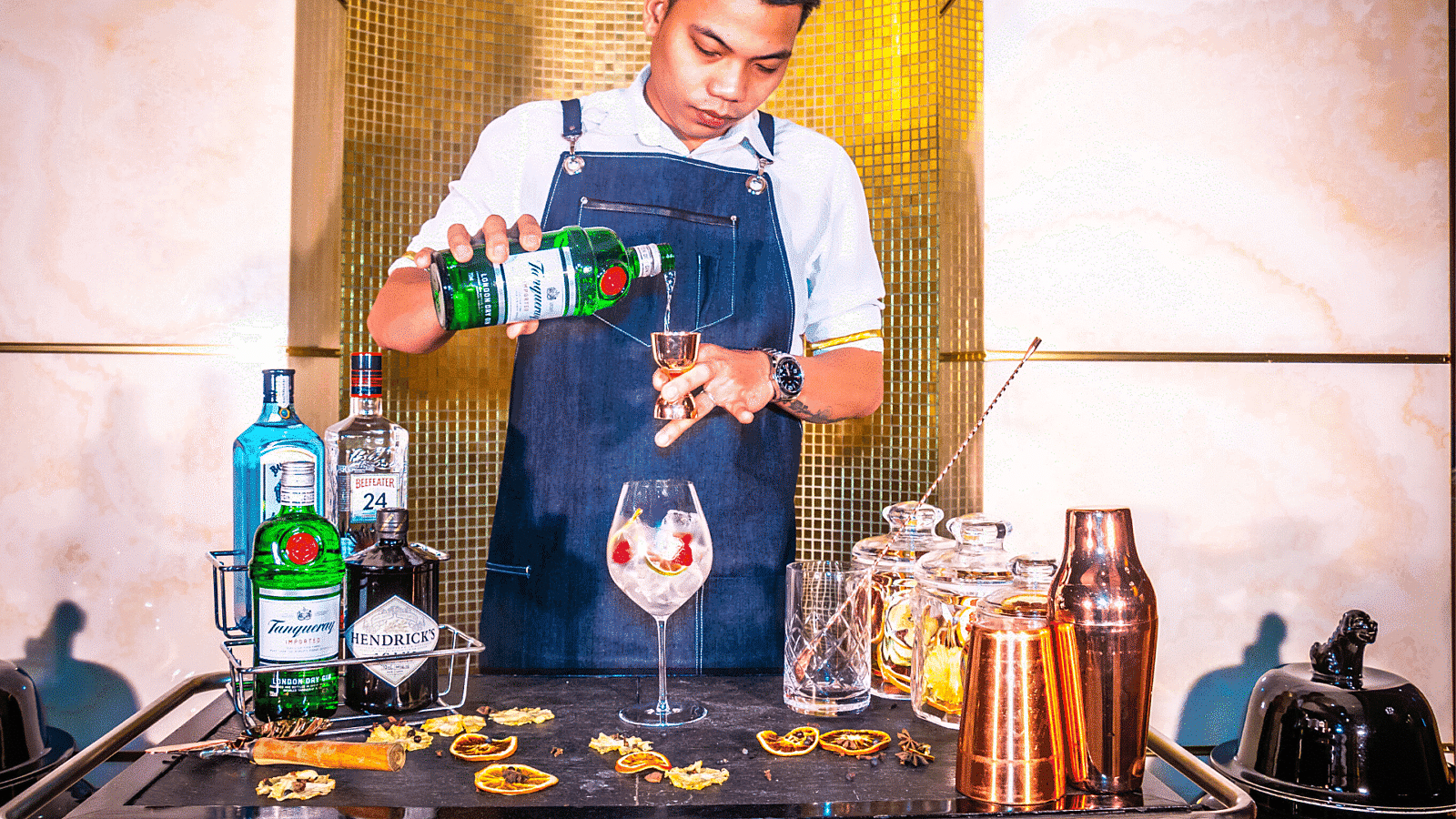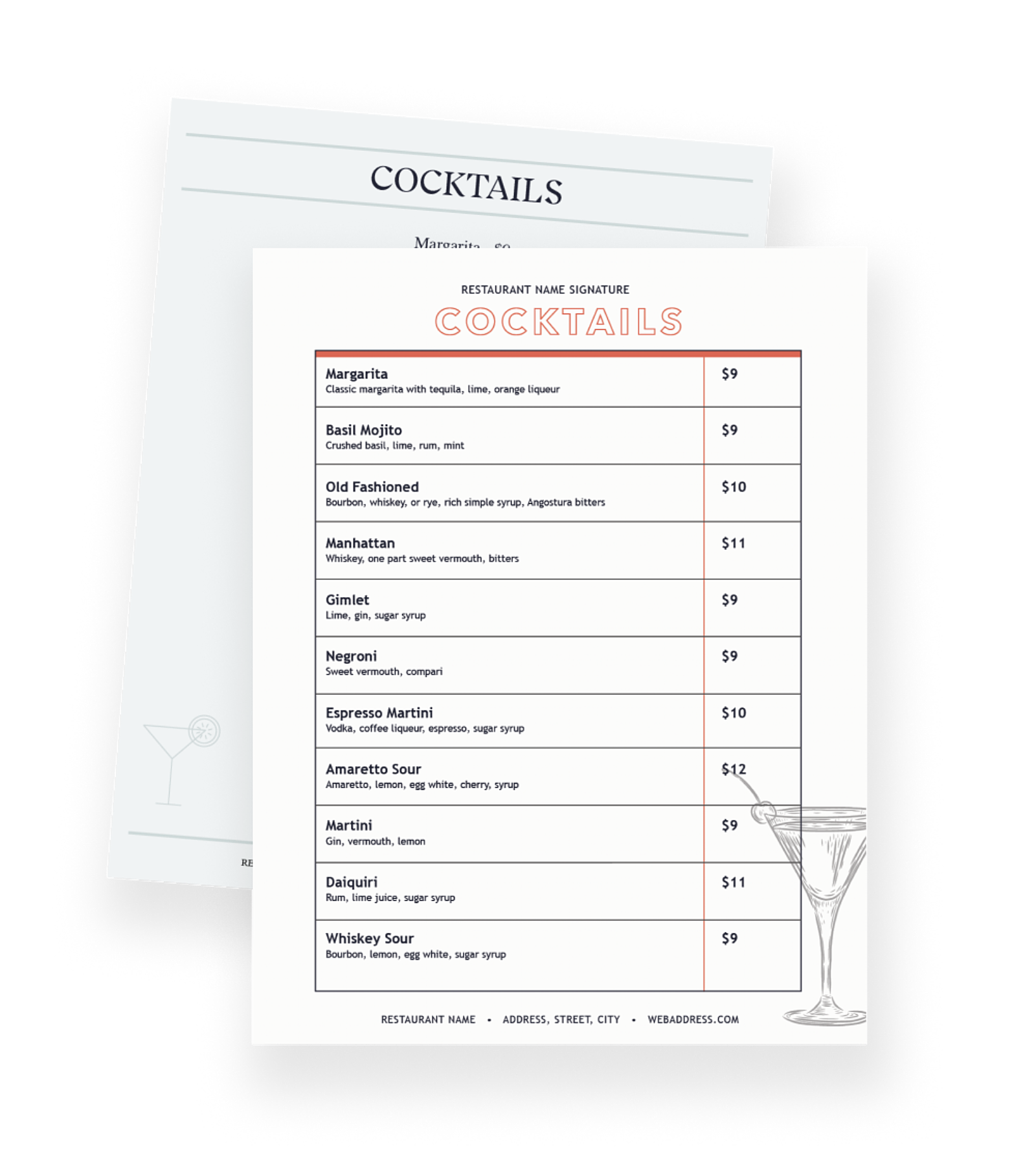
How to Price a Cocktail Menu
From calculating COGs to adjusting for inflation, here’s what to know about pricing cocktails at your bar or restaurant.

Caroline PriceAuthor


Cocktail Menu Templates
Use these cocktail menu templates as a starting point for your menu design or to give your menu a refresh.
Get free downloadYou’ve launched a successful bar and created a killer drinks menu. Now, you need to figure out how to price your cocktails. Whether you’re a fledgling bar owner or an accomplished restauranteur, it’s a scenario that all business owners must face. Even the largest sports bar in the world, Buffalo Wild Wings with two billion in revenue, must constantly evaluate their price points to bring value to customers while driving the growth of their business.
Correct pricing can result in more customers, a larger share of the market, and, ultimately, increased profits. But just as no two cocktails are alike, there’s no plug-and-play formula to follow. You may find a margarita for $16 in one bar and a $10 version in a different joint just down the street, and both have similar profit margins. Think of pricing as a strategic tool that reflects your establishment’s singular identity and unique position in the market.
In this article, we’ll examine the key factors that influence pricing decisions. These include clear-cut factors like the cost of ingredients and labor. We’ll also tackle the tricky stuff that’s difficult to pin down, like overhead costs and indirect labor. Then, we’ll share step-by-step methods to calculate costs and set prices for your business.
Read on for key strategies and insights to properly price a cocktail and give your bar the best chance of success.
Cocktail Menu Templates
Use these cocktail menu templates as a starting point for your menu design or to give your menu a refresh.

Understanding the Basics of Pricing of Cocktails
Simply put, pricing is the process of determining how much money you’ll charge for your alcoholic beverages. It’s a crucial part of being a bar or restaurant owner for many reasons.
Business Longevity
Market conditions change, and business owners must be flexible enough to adjust prices in response to economic shifts, drink trends, and customer demand to achieve sustainability. We’ve all experienced first-hand the high cost of ingredients and supply chain issues of recent years. Unfortunately, bars that charge 2019 prices today cannot expect to thrive.
Competitive Strategy
Finding the balance between profitability and competitiveness will be an ever-present challenge. Bartenders and bar owners must look to rivals to ensure their cocktail menu is competitive and adjust pricing accordingly while always keeping profitability in mind. This may mean cutting prices to gain market share or, on the flip side, raising prices to signify higher quality.
Pricing Considerations
It’s more than just gin, vermouth, and a green olive that go into the price of a classic Martini. To determine your pricing, think about every action that contributes to creating your cocktail. This will include ingredient costs, labor costs, and overhead expenses, such as rent, utilities, and insurance. You can’t stop there. Zoom out even further to evaluate overall market demand and what your competitors are doing right and wrong. Pricing one single mimosa or mai tai requires a holistic approach with big-picture thinking.
Calculating Your Costs
Start by pondering this question: how much does it cost to produce one unit of X? Ingredients will likely jump to mind first, but you might be surprised by all the factors impacting the Cost of Goods Sold (COGS). It’s no picnic figuring out your COGS, but it’s essential to pricing, providing a baseline amount you should never go below. There are many unknowns when launching a business, but one thing is for sure: You don’t want to sell alcoholic beverages for less money than it took to make them. Here, we break it down.
Recipe Costing
Recipe costing software takes the pain out of the process, saving time and expensive mistakes, but you can do this manually with a spreadsheet or Recipe Cost template. Write down each ingredient in your cocktail, and next to each ingredient, put the measure used (weight, volume, or number). Compute the actual food cost of each ingredient by determining the unit of measure per recipe portion size based on the total cost per purchased unit. Say that a 1.75-liter bottle of Tito’s vodka costs you $30 and contains about 39 shots worth of alcohol. If you use one shot in a Bloody Mary, the cost of the vodka will be 77 cents per drink. Continue to add up the individual cost of each ingredient to get the total cost for each recipe.
Be sure to account for food waste in your calculations since some spoilage, mismeasurements, and spillage are inevitable. For tips on monitoring spoilage, check out our guide to conquering food waste.
Labor Cost Calculation
Labor costs include more than just hourly wages, typically making up about 30% of a business’s revenue. Anything that can be categorized as “labor-related” goes into your labor cost calculation, and there are two main buckets: Direct labor and indirect labor. Direct labor encompasses regular wages, overtime hours, insurance, and paid time off. Indirect labor includes fringe benefits like bonuses and uniforms.
Once you’ve done the heavy lifting to determine your labor costs (direct and indirect), plug your numbers into this formula:
Hourly labor costs x hours of labor per unit = cost of labor per baked good.
Overhead Cost Calculation
For a truly accurate pricing strategy, operational overhead expenses must be factored into every mojito and Manhattan that you mix.
Fixed costs are constant no matter what you decide to sell. These include rent, property taxes, business loan payments, and monthly rental of bartender equipment. Then come the variable costs, which fluctuate monthly depending on your output, like electricity used to power machinery, maintenance costs for your equipment, those tiny umbrellas, straws, stirrers, or other important accouterments for your drinks. To calculate the overhead costs per cocktail, use this formula:
The total amount of overhead costs (fixed and variable) incurred during a period / the total number of units produced = per unit overhead.
Total Cost Per Item Calculation
Now comes the moment of truth where you discover the total cost per item, which is crucial to setting the price of your cocktails.
Recipe Cost + Labor Cost + Overhead Cost = Total Cost Per Item
Setting Your Prices
Congratulations. Just by determining your COGS, you’ve already won half the battle. Now it’s time for the fun stuff: setting the right price so you can rake in the profits and grow your business.
Determine Your Markup
The markup percentage varies from establishment to establishment and is influenced by other costs such as target profit, overhead, and more. With those disclaimers out of the way, markups on cocktails typically range from 60 to 80 percent, so for every $10 a customer spends, expect to earn $6 to $8.
Pricing Strategies
Cost Plus Pricing is the most popular but it has its pros and cons. On the plus side, it’s the most simple and straightforward approach: the business owner calculates all costs (fixed and variable) for a product and then simply applies a markup percentage to determine the selling price.
The drawback is that when a cocktail costs less money to make, you earn lower revenue and total profit. On the other hand, a bloated cost structure may force you to set higher price points to cover unnecessary expenses, and customers may not be willing to pay that much.
Value-Based Pricing is a powerful strategy that sets prices based primarily on a consumer’s perceived value of a product. It is customer-focused, meaning your bar business will base the pricing on how much your customers believe your cocktails are worth. Rather than costs dictating how much you charge, this approach gives you more control over pricing and is a great fit for bars offering inventive libations that set them apart from the competition.
The trick is that it requires a deep understanding of the local market, which only comes from time and research, two things you might be short on when managing a bar.Competition-Based Pricing. As its name suggests, this involves setting price points relative to your competition. You have three choices: below the competition, at the competition, or above the competition. It’s a popular approach for businesses selling similar products that customers already know and love – and when a price has reached an “equilibrium.” For instance, there’s not much variation when it comes to classics like Jack and Coke.
To charge more than competitors, your bar must deliver a premium experience. Pricing below competitors, on the other hand, risks taking a loss and hoping customers will buy other menu items to make up for it (known as the Loss Leader Strategy). Those who match competitors’ pricing must distinguish themselves in different ways, like through marketing or a stellar atmosphere.
Considering Price Elasticity
Buyers' responsiveness to changes in prices can be elastic, meaning a change creates a larger demand. Or it can be inelastic, with no change in demand. To give you a better idea, necessities like groceries and utilities are generally considered inelastic, with demand remaining the same even when prices increase. Where do bars stand? Typically, restaurants and bars are considered inelastic since enjoying a nice cocktail after work is not a daily need (though that’s debatable!). In other words, your customers will be more sensitive to changes in price.
Factoring in Perceived Value
This is where a great marketing strategy comes into play. Perceived value is your customer’s perception of your cocktails’ desirability, especially in comparison to a competitor. If your mixologist is known to be the best in town or you stock hard-to-find premium spirits, the theory is customers will be willing to pay more at your establishment.
Setting Different Prices for Different Sales Channels
These days, you’re not limited to selling cocktails at a bar or restaurant. There are multiple sales channels, including private events and food festivals. Some states, like California, allow alcohol delivery and cocktails to go. Each distribution channel will have different profit margins, and you can customize pricing to maximize profits and appeal to different types of customers.
Restaurant Cost Control Guide
Use this guide to learn more about your restaurant costs, how to track them, and steps you can take to help maximize your profitability.

Adjusting and Optimizing Your Prices
The decision to raise or lower prices is fraught with worries, but if price adjustments are implemented correctly, you can actually strengthen your connection with customers.
Monitor and Analyze Sales Data
A spreadsheet or another data analysis tool can help you spot sales trends and buying patterns for individual cocktails, providing insight on how and when to adjust your prices. For instance, many businesses raise prices slightly during the holidays when people pay less notice to markups. On the other hand, brand-new bars might delay price hikes to gain market share if sales are slow.
Conduct Regular Market Research
Market research may involve surveys, soliciting feedback, and customer interviews — it sounds like a lot, but getting to know your target audience and their buying habits will help grow your business in many ways. You’ll use the data to hone your menu of specialty drinks, develop your marketing strategy — and, of course, set prices. This will also come in handy with channel pricing as you figure out which drinks to market to which segments.
Adjusting Your Prices
Changes in cost: When your costs go up due to inflation or other factors out of your control, adjusting prices requires a nuanced approach so your customers don’t go nuclear. One method is to tailor adjustments to customers who may be less sensitive to pricing. For instance, those willing to pay $50 for a shot of Johnnie Walker Blue Label may not balk at $60, but a slight increase on a gin and tonic might get pushback. Another approach is slowly implementing price changes on one or two cocktails and then assessing the response.
Seasonal factors: The first step of a seasonal pricing strategy is to identify your busy times of the year. It could be based on holiday demand, weather conditions, or driven by community events that spur an influx of customers. After pinpointing your key seasons, establish a base rate for your cocktails or the lowest you’re willing to go to break even. Seasonal rates are typically higher or lower than your base rate, depending on demand in that season.
Market demand: In this approach, you’ll charge higher prices during high-demand periods and lower prices during low-demand periods. Your market research data will help you understand your customers’ behavior so that you can predict the ebbs and flow of future demand.
Competitor pricing: whether you’re undercutting your rivals, benchmarking, or charging a bit more for higher quality, it make sense to look at your competitors when adjusting prices.That said, it’s always important to do your due diligence first to ensure their prices are accurate and align with what consumers are willing to pay. Keep in mind that the pricing needs to work within your cost structure, not only covering your COGS but also ensuring a healthy profit margin.
Implement Promotional Pricing Strategies
Loyalty cards, happy hours, and group rates with bottle service are all ways to leverage changes in demand and keep your barstools full. The trick is to use them wisely. For instance, if a large group pays a certain amount up front to hold a booth reservation with bottle service, you can offer them discounts on individual cocktails.
Communicate Price Changes to Customers
Honesty is the best policy: customers appreciate transparency around price changes. Who among us is not excited about a killer happy hour or discounts on drinks? On the flip side, informing customers about increases and explaining the reason why prices are higher goes a long way toward building trust.
Pricing is more complex than it seems, but a nuanced, well-thought-out approach will keep your customers happy and lead you to profitability. There’s no “magic number” for any one cocktail, but following these strategies will get you pretty darn close.
Restaurant Menu Templates
Use these menu templates as a starting point for your menu design or to give your menus a refresh.

Is this article helpful?
DISCLAIMER: This information is provided for general informational purposes only, and publication does not constitute an endorsement. Toast does not warrant the accuracy or completeness of any information, text, graphics, links, or other items contained within this content. Toast does not guarantee you will achieve any specific results if you follow any advice herein. It may be advisable for you to consult with a professional such as a lawyer, accountant, or business advisor for advice specific to your situation.
Subscribe to On the Line
Sign up to get industry intel, advice, tools, and honest takes from real people tackling their restaurants’ greatest challenges.
